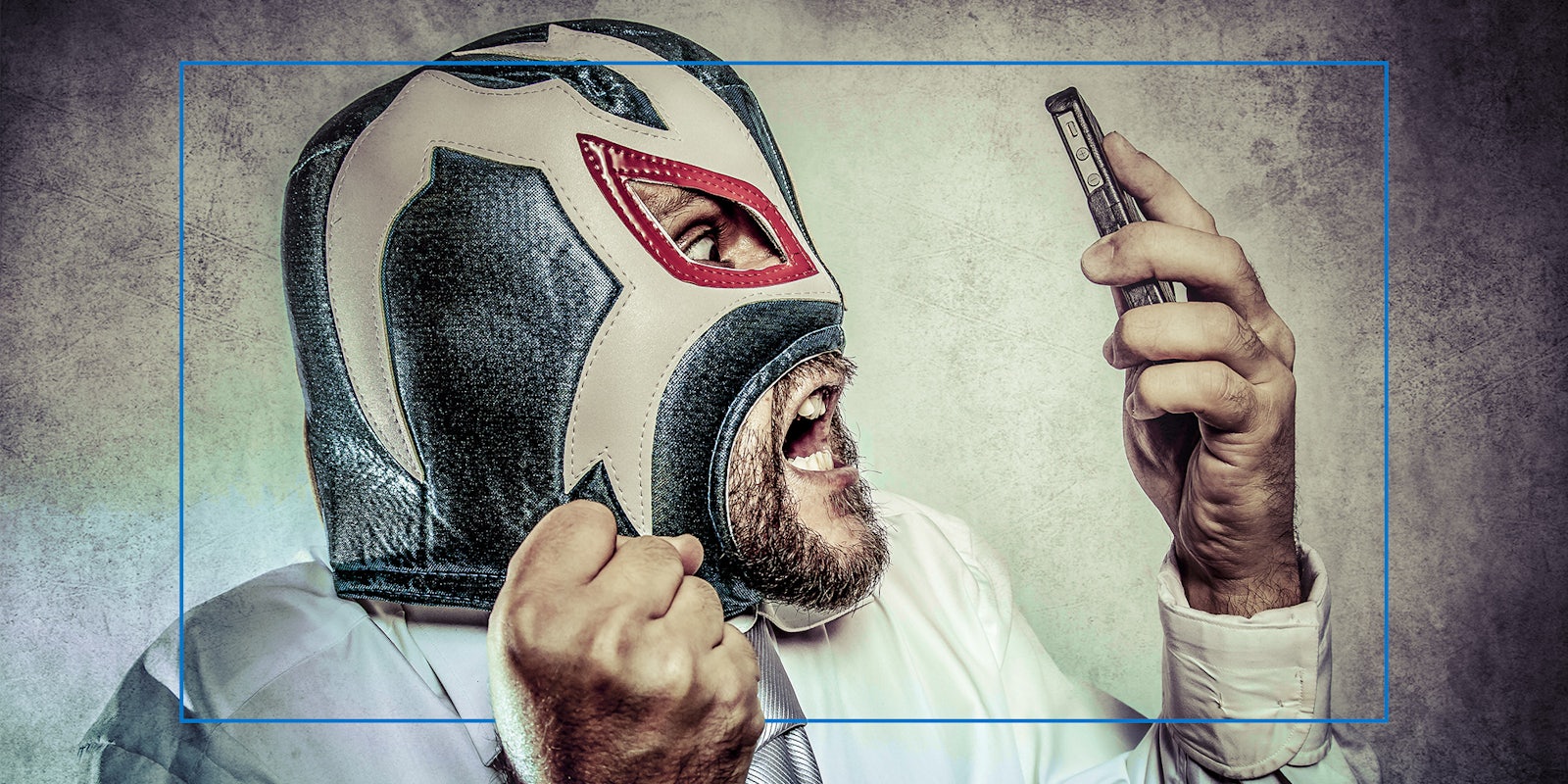Professional wrestling’s viral nature traces back to Rey Mysterio Jr., who’d go on to become the world’s most famous luchador—and expand lucha libre to reach new fans all over the world.
The Mexican-American debuted in the U.S. for Philadelphia’s independent promotion, Extreme Championship Wrestling (ECW), in the mid-‘90s. Because ECW only had regional TV distribution, it adopted usage of the internet as a means for distribution early on—and Mysterio grew in popularity, thanks to dial-up downloads of .mpg clips and forum buzz on AOL’s Grandstand, long before his contemporaries.
Preeminent wrestling journalist Dave Meltzer told the Daily Dot the luchadores were “really popular among ECW fans” and once World Championship Wrestling (WCW) poached them, luchadores had their “cool” factor elevated on TNT and TBS networks. The lucha contests in every iteration “were out of this world,” according to Meltzer, “with good flying that was ahead of its time.”
The roughly 5-year window that WCW featured lucha and the ECW precedents is now celebrated on social media 25 years later. Rappers shout-out those lucha stars. Like music sampling, and movie remakes/reboots, what’s old is new again. YouTube hosts classic matches from official channels. Pro wrestling’s top subreddit, Squared Circle (with 600,000 subscribers), calls back those luchadores, moves, and matches on any given day.
Andreas Hale, senior editor of combat sports at Sporting News, and host of both The Corner and the Wrestling with Stereotype podcasts, often encounters disbelief from fans online discovering how much lucha in the ‘90s holds up today.
“It changed the entirety of wrestling culture as we know it,” said Hale. “Now lucha style is adopted into all pro wrestling styles.”
Kel Dansby, who co-hosts both podcasts with Hale and runs ESPN’s Ringside on social media, believes the lucha style is a natural fit for today’s digital landscape. “It lends itself to the shorter attention span, the shorter clips, that now are circulating and become popular on social media.”
Lucha libre promoter Gabriel Ramirez of Pro Wrestling Revolution is glad to see the appreciation decades later, but said that the platform WCW granted lucha also came with its own set of problems.
“When you saw the elaborate outfits for lucha, people would start downplaying it,” said Ramirez, who operates a lucha school that trained former UFC heavyweight champ Cain Velasquez for Velasquez’s debut in Mexico’s lucha promotion AAA. Knowing Mysterio, Psicosis, and Guerrera were all unmasked in WCW—what’s supposed to be a sacred, years-long payoff—without rhyme or reason still stings. WCW “took a dump” on lucha traditions.
Hale agrees, but remains grateful for the conversations about pro wrestling that have stemmed from social media. “Fortunately, the internet has allowed people who respect the culture to project that to audiences who would also like to respect the culture—‘cause I wanted to respect lucha wrestling, but when it was presented by the [WCW and WWF] colonizers, it was a joke,” said Hale. “It was the circus coming to town rather than being a respectable culture.”
Thanks to the roadmap Mysterio, Psicosis, Guerrera and others set in the ‘90s, this generation of Mexican lucha stars have been able to carve out careers by creating internet buzz through American independents. They can make more money bolstering U.S. indies than they can as top stars in Mexico, which in turn increases their value globally, and creates a more inclusive wrestling scene.
Pentagon Jr. and Rey Fenix are today’s trailblazers in this regard. They parlayed time on the independents —including the short-lived yet influential Lucha Underground show in the mid-2010s—to become flagship stars on TNT and TBS’ new pro wrestling property, AEW.
“It becomes like lore in wrestling, and it was just a couple of years ago,” said Dansby of lucha within the modern indies. “It’s an inside club that’s really cool for another generation to really explore and get into.”
Meltzer senses there is now an increased understanding of lucha libre culture in the United States. “I’ve seen in the last several years, non-Mexican-American fans throwing money at the lucha matches, booing when they go for the masks,” he said.
Young Mexican wrestlers know going viral can transcend language and other barriers to entry. New Japan Pro Wrestling, Japan’s top promotion, has always cross-pollinated with lucha libre because the Japanese always respected it—the streaming service New Japan World features decades of this intercontinental relationship.
Lucha libre connects with online audiences because its influence on modern wrestling is undeniable. All Elite Wrestling’s position—since it exchanges talent with New Japan and AAA and lets their roster work independent circuits—is a natural torchbearer to expand lucha libre’s U.S. presence. Meltzer described lucha libre in AEW as “another bullet in their holster.” He believes AEW is leaving money on the table if it doesn’t push lucha stars in the future.
“Lucha wrestling is not disposable once you understand where it came from, the talent that created it, the owners of that style,” said Hale. “Now it’s very shareable and hopefully it gets the respect it deserves.”


